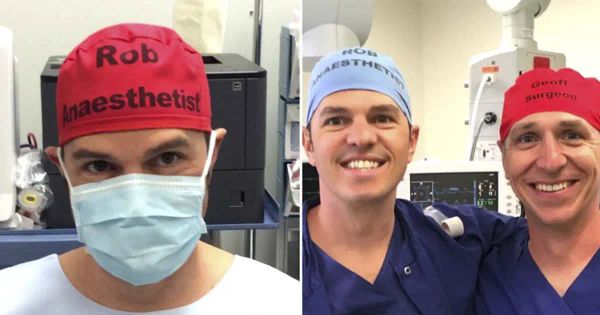Imagine being in a life-or-death situation and struggling to communicate with the medical staff around you. This was a reality for Dr. Rob Hackett, an Australian doctor, until he came up with a simple yet effective idea that has now become a global trend.

Dr. Hackett started writing his name and occupation on his scrub cap, allowing others in the operating room to quickly identify him and understand his expertise. This small change has not only saved lives but also improved communication and efficiency in medical settings.
Overcoming Initial Resistance
When Dr. Hackett first started writing his name on his scrub cap, his colleagues made fun of him. They couldn’t understand why he felt the need to label himself. However, within a year, this trend caught on and spread across the medical industry worldwide. Dr. Hackett is now working with the PatientSafe Network to make this practice the norm globally. The hashtag #TheatreCapChallenge is being used on social media to encourage medical staff to share pictures of their labeled caps.
The Benefits of Naming Scrub Caps
Beyond the obvious advantage of improved communication, there are several other benefits to having names and occupations displayed on scrub caps. For medical staff, it fosters a sense of camaraderie and reminds them that they are not just faceless individuals behind masks. Studies in the UK have shown that name recall among hospital staff increased from 42% to 85% when names were displayed on scrub caps. Additionally, introducing oneself by name and role, as part of the surgery safety protocol checklist, increased from 38% to 90%.
Patients also benefit from this practice. For those who need to be awake during procedures, such as individuals undergoing cesarean sections, knowing the names of the medical staff in the room provides reassurance and reduces fear and confusion. Furthermore, the adoption of reusable scrub caps with printed or sewn names and occupations has an environmental impact, reducing waste and saving hospitals thousands of dollars annually.
Overcoming Challenges
Despite its numerous advantages, the movement to label scrub caps has faced resistance from senior hospital staff. Dr. Hackett believes this resistance stems from ego and a reluctance to admit that a new approach is superior to the traditional way of doing things. While the movement has received support from anesthetic and obstetric societies, surgical colleges have not actively endorsed it yet. Dr. Hackett emphasizes the need for change and acceptance within healthcare, acknowledging that past practices may have inadvertently caused harm to patients.
In conclusion, the initiative of naming scrub caps has positively transformed the lives of medical staff and improved patient care. By continued adoption across different countries and fields, this practice can create a better working environment in hospitals worldwide. Let’s support this simple yet transformative trend for the benefit of all.





